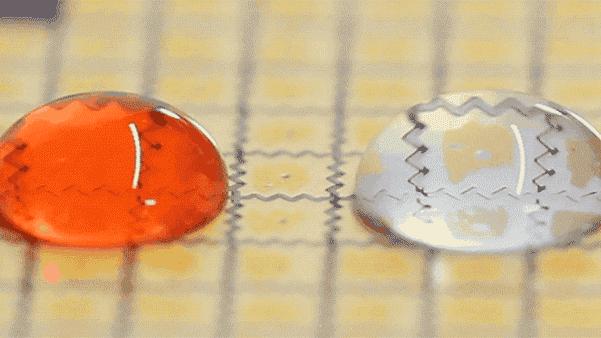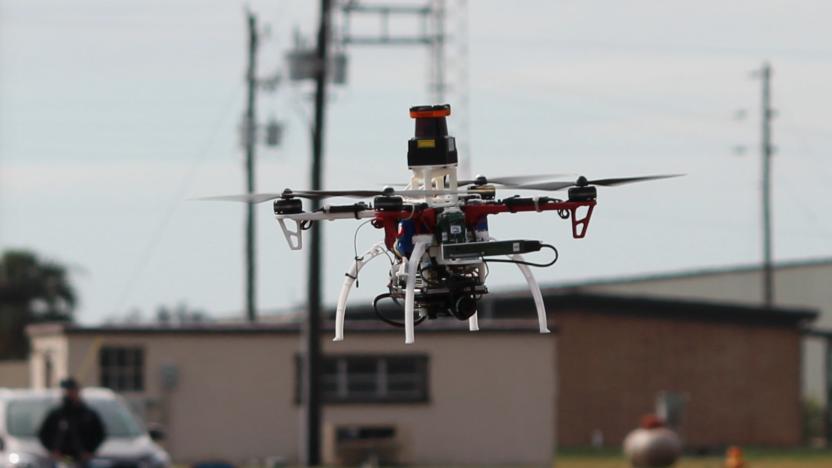MIT
Latest

MIT's autonomous drone is equal parts albatross and sailboat
"The oceans remain vastly under-monitored," said Gabriel Bousquet, an MIT postdoc who led the design of a unique robot as part of his graduate thesis. "In particular, it's very important to understand the Southern Ocean and how it is interacting with climate change. But it's very hard to get there." Bousquet and his team designed a hybrid vehicle that can both fly above tumultuous seas and sail on them when things are calmer. The vehicle uses one-third as much wind as an albatross would and travels ten times faster than a typical sailboat, making for a very efficient way to survey the vast areas of the planet's seas.

MIT's self-driving car can navigate unmapped country roads
There's a good reason why companies often test self-driving cars in big cities: they'd be lost most anywhere else. They typically need well-labeled 3D maps to identify curbs, lanes and signs, which isn't much use on a backwoods road where those features might not even exist. MIT CSAIL may have a solution, though. Its researchers (with some help from Toyota) have developed a new framework, MapLite, that can find its way without any 3D maps.

Atmospheric harvesters will enable arid nations to drink from thin air
As climate change continues to wreak havoc upon the Earth's weather patterns, formerly lush locales like the American West are finding themselves increasingly parched. Perhaps nowhere is that abrupt arridization more pronounced than in Cape Town, South Africa. Since 2015, the region has suffered severe droughts and the coastal capital of 4 million people has struggled to maintain a steady municipal water supply.

MIT researchers turn water into 'calm' computer interfaces
Our lives are busy and full of distractions. Modern computing. with its constant notifications and enticing red bubbles next to apps, seems designed to keep us enthralled. MIT Media Lab's Tangible Media Group wants to change that by crafting "calm interfaces." The Tangible Media Group demonstrated a way to precisely transport droplets of liquid across a surface back in January, which it called "programmable droplets." The system is essentially just a printed circuit board, coated with a low-friction material, with a grid of copper wiring on top. By programmatically controlling the electric field of the grid, the team is able to change the shape of polarizable liquid droplets and move them around the surface. The precise control is such that droplets can be both merged and split. Moving on from the underlying technology, the team is now focused on showing how we might leverage the system to create, play and communicate through natural materials.

With Squadbox, friends moderate harassing messages in your email
Researchers at MIT's Computer Science and Artificial Intelligence Laboratory have developed a tool aimed at fighting harassment online. It's called Squadbox and the idea behind it is to have your friends or coworkers moderate your incoming messages for you. The research team interviewed a number of people who had experienced online harassment in the past and then designed Squadbox's features based on those conversations.

MIT's wearable device can 'hear' the words you say in your head
If you've read any sort of science fiction, it's likely you've heard about subvocalization, the practice of silently saying words in your head. It's common when we read (though it does slow you down), but it's only recently begun to be used as a way to interact with our computers and mobile devices. To that end, MIT researchers have created a device you wear on your face that can measure neuromuscular signals that get triggered when you subvocalize.

Researchers create robotic fish that can swim underwater on its own
Observing fish in their natural ocean habitats goes a long way toward understanding their behaviors and interactions with the surrounding environment. But doing so isn't easy. Using underwater vehicles to get a look at these species is one option, but they often come with a slew of limitations. Some are loud and use propellers or jet-propulsion that disturb fish and their surroundings. And many are designed in a way that doesn't allow them to blend in with the marine environment. Controlling such vehicles is also a challenge and in many cases, they have to be tethered to a boat. But researchers at MIT's Computer Science and Artificial Intelligence Laboratory (CSAIL) have come up with a potential solution -- a soft robot that can swim on its own underwater.

MIT embarks on ambitious plan to build nuclear fusion plant by 2033
MIT announced yesterday that it and Commonwealth Fusion Systems -- an MIT spinoff -- are working on a project that aims to make harvesting energy from nuclear fusion a reality within the next 15 years. The ultimate goal is to develop a 200-megawatt power plant. MIT also announced that Italian energy firm ENI has invested $50 million towards the project, $30 million of which will be applied to research and development at MIT over the next three years.

MIT's robotic carpenters take the hassle out of custom furniture
If you want to build custom furniture, you usually need to know your way around a saw and devote days to both designing it and cutting every last piece. MIT's CSAIL might have a better solution: let computers and robots do the hard work. Its researchers have developed an AutoSaw system that makes it easy to craft furniture without the risk of cutting your fingers. You start on your computer by customizing furniture templates in OnShape's simple CAD system. After that, modified robots (a Roomba for a jigsaw, Kuka youBots for chopping) cut the individual parts. You still have to assemble it yourself, but the software will guide you through the process.

MIT's Veil service will make private browsing more private
After reports and studies revealed that browsers' private modes aren't that secure, MIT graduate student Frank Wang decided to take things into his own hands. He and his team from MIT CSAIL and Harvard have created a tool called Veil, which you could use on a public computer -- or on a private one on top of using incognito mode and Tor if you have big secrets to keep or if you've just become paranoid after years of hearing about hacks and cyberattacks.

Device provides years of power through temperature swings
Eventually, you might not need a battery or a conspicuous external power source to keep a device running for years on end. A team at MIT has created a device that produces energy by exploiting the temperature swings that occur between day and night. Known as a thermal resonator, it uses a hybrid of materials that produce both high heat conduction and capacity. A copper or nickel foam at its core is coated with graphene to boost its conductivity, and is infused with a phase-changing material (octadecane) that serves as storage. Effectively, one side of the device is always capturing heat while the other is storing it -- you just have to harvest that energy with conventional techniques.

MIT has a new chip to make AI faster and more efficient on smartphones
Just one day after MIT revealed that some of its researchers had created a super low-power chip to handle encryption, the institute is back with a neural network chip that reduces power consumption by 95 percent. This feature makes them ideal for battery-powered gadgets like mobile phones and tablets to take advantage of more complex neural networking systems.

MIT’s low power encryption chip could make IoT devices more secure
The Internet of Things hasn't ever been super secure. Hacked smart devices have been blamed for web blackouts, broken internet, spam and phishing attempts and, of course, the coming smart-thing apocalypse. One of the reasons that we haven't seen the same sort of encryption as the web affords, however, is that such protection is energy-intensive. MIT is working on a new chip, however, to perform this sort of public-key encryption that only uses 1/400 as much power as a software solution would. In addition, the chip uses about 1/10 as much memory and executes processes 500 times as fast.

MIT CSAIL’s drone is never quite sure where it is
The current generation of autonomous drone navigation and flightpath planning systems are almost too precise, demanding hundreds of measurements be taken so that the UAV knows exactly where it is in space at any given moment. And if those readings are off by even a little, then the drone is in for an impact. What's more, all that data collection is computationally intensive -- especially for smaller drones where the space and weight capacities are limited.

MIT's ColorFab can 3D print jewelry that changes colors
3D printing can already turn your amazing ideas into tangible objects, but a new technique out of MIT CSAIL could lead to even better results. The method, called ColorFab, gives you the ability to create objects that can change colors after you print them out. You can use it, for instance, to create a phone case or a pair of earrings that matches your red dress today and will also match your blue pantsuit tomorrow. ColorFab's magic lies in the CSAIL team's custom-made ink, which has base dyes and light-adaptable or "photochromic" dyes. The light-adaptable dyes bring out the color in the base dyes when exposed to UV light. Under visible light, the colors disappear, and the ink turns transparent.

'Artificial synapse' points the way toward portable AI devices
Tech titans like Intel and IBM have already begun developing chips for AI that mimic the way the human brain works -- it is, after all, the most powerful computer there is. The field of "neuromorphic computing" is still in its very early stages, though, and one of its pioneers' greatest challenges is copying neural synapses. Those are the small structures where information passes when it moves from one neuron to the next. That's why a team of MIT engineers have set out to develop an artificial synapse that works like the real deal and have successfully come up with a design that can "precisely control the strength of an electric current flowing across it, similar to the way ions flow between neurons."

MIT is redesigning power converters to make the grid more efficient
Electrical efficiency affects a massive number of devices, from the relatively tiny phones in our pockets all the way up to electric cars and the power grids keeping our houses running. Power converters are a particularly important part of the equation, as they're the devices that bring the high voltages coming through power lines down to more manageable levels for household outlets. MIT, along with semiconductor company IQE, Columbia University, IBM and the Singapore-MIT Alliance for Research and Technology have announced some breakthroughs on making that part of the equation more efficient.

MIT researchers made a living ink that responds to its surroundings
Researchers at MIT have developed a 3D printable hydrogel that can sense and respond to stimuli. The hydrogel is loaded with bacteria that can be genetically programmed to light-up when they come in contact with certain chemicals and, therefore, could be used as living sensors.

MIT's DIY muon detector sniffs out cosmic particles
Scientists at MIT have designed a pocket-sized muon detector that can be easily made with common electrical parts, meaning anyone can kit themselves out with legitimately-functional Ghostbusters-esque gear for less than $100. The device detects the charged particles -- muons -- that come from the high-energy cosmic rays blasted from supernovae beyond the solar system. These particles last only a fraction of a second but can be found in every layer of the planet's atmosphere, with some even penetrating the Earth's surface and burrowing into rock and ice.

MIT students trick an AI into classifying this turtle as a gun
We're relying increasingly on AI to be able to detect things, from exotic states of matter to recognizing specific faces, but how easy is it to fool these mechanisms? That's what researchers wanted to find out. A group of students took on the task of figuring out how exactly to reliably and consistently trick a neural network into consistently misidentifying an object.








